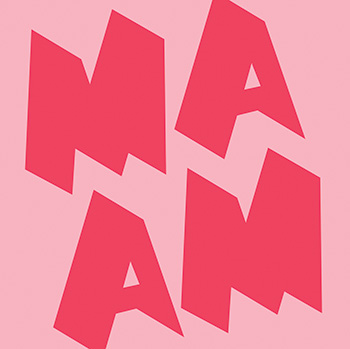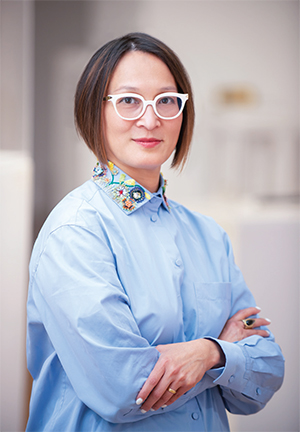MAAM: MassArt’s New Art Museum
![]()
Momo Pixel. Still from Momoland 4, 2018. Interactive pixel-art installation. Courtesy of the artist.
Strike up the band—a new art museum opens in Boston on February 22, 2020. The Massachusetts College of Art and Design’s MassArt Art Museum (MAAM), a renovation of the long-standing Bakalar & Paine Galleries, is devoted to the presentation and experience of contemporary art. It was ten years in the making, a decade of dreaming and talking, planning and building, with some serious fundraising along the way.
In 2008, when Lisa Tung was promoted from senior curator to executive director of the Bakalar & Paine Galleries, she asked herself, “What should this space be like in 10 to 15 years?” Implicit in her question, was another: How can a museum at MassArt—the nation’s
first publicly supported freestanding art school—better serve the college’s students and faculty and its broader community?
At the time, the galleries were housed in the college’s South Building, a stately edifice built in 1906, somewhat removed from the college itself. Its facilities were worn down; it had few visitor amenities and no elevator; the space felt gerrymandered and temporary—and it was hard to find.

Tung sought the guidance of a museum consultant who produced a 40-page strategic plan that stressed four key “musts”: create a front door to announce the museum’s presence; professionalize the facilities to best serve exhibitions, programs and visitors; expand educational
programs and community outreach; and fashion a brand. Tung had her road map.
That vision of the museum was incorporated into the college’s master plan. Yet because it didn’t fulfill the state’s capital improvement requirements, Tung had to pursue private donations. The project was supported by MassArt’s UNBOUND capital campaign, which raised $12.5 million, making it the largest privately funded campaign in the college’s history.
The new space has been thoroughly reimagined and reconfigured, and the four tasks have been amply fulfilled. There is now an easily identified entrance, fronted by a newly landscaped plaza, and opening to a lobby with a welcome desk, and, to the right, for all visitors to see, a brightly lighted educational studio. Next, through glass doors, there’s a good-sized yet intimate gallery; then, via the stairs or the elevator, up to the main gallery, a large, airy space that soars to a 36-foot-high ceiling, exposing the original terracotta vaulting and steel trusses, and featuring an art-viewing (and people-watching) balcony. Behind the scenes, there are preparator’s and registrar’s rooms, offices, and a staff and intern room (with lockers for the interns). All of it is served by a new industry-standard climate control system.

Tung likes to refer to the newly refurbished space as a Kunsthalle, a noncollecting art museum with no permanent collection that presents rotating exhibitions. “As a teaching museum at MassArt, which offers 19 fields of study,” says Tung, “we align ourselves to what’s being taught. We hire over 50 students a year as paid interns to work throughout the museum, learning what it takes to be a museum professional.”
The fourth “must-do” task, creating a brand, generated what the museum needed: some spunk. It now has a catchy nickname—MAAM—evoking MOMA plus BAM. MAAM has adopted a crisp, versatile, straight-lined logo. On its website, front and center, the museum has rolled out its tagline, “Imagine the unimagined,” displayed in the museum’s bespoke font. Bright colors enliven the MAAM website. The branding program delivers the message that MAAM is a vibrant place with a revitalized purpose.
MAAM inaugurates its exhibition programming with the debut of a monumental site-specific installation by Portuguese artist Joana Vasconcelos, best known for her multimedia works. Her first work to debut in the United States, the Valkyrie Mumbet is the newest in her Valkyries series, named after Norse female war goddesses, which salutes inspiring women in history, literature and popular culture.
Vasconcelos’s soaring, colorful fabric sculpture pays tribute to the courageous Elizabeth “Mumbet” Freeman, a slave whose victorious court battle for her freedom in 1781 helped make slavery illegal in Massachusetts. Visitors will have views of it from the main gallery floor and the viewing balcony.

Game Changers: Video Games and Contemporary Art, the second inaugural exhibition, features an international roster of artists working at the confluence of art and video games. Pushing narrative and technological boundaries, the pieces range from playable works (such as Pro Revolution Soccer by MassArt professor Juan Obando) to narrative works (such as Skawennati’s Time Traveler). “In contemporary art,” says the exhibition’s curator, Darci Hanna, “there are always new frontiers to explore. I hope that visitors to Game Changers will get an appreciation of game-related video as a thought-provoking, relatively accessible medium that can tell new and important stories and widen our horizons.”
The third of the museum’s opening exhibitions is a work by Ghost of a Dream, the artistic team of Adam Eckstrom and Lauren Was, based in upstate New York. Their intricately patterned, site-specific installation, Yesterday is Here, activates
the lobby. “Our work is often made from printed materials, from the ephemera people create in pursuit of their dreams and hopes,” says Eckstrom. Here they’ve mined 30 years of MassArt exhibition catalogs and announcements, cut them up and repurposed them into a kaleidoscopic array that covers all of the lobby walls and succeeds in looking back as well as forward. “We’re taking moments in history,” says Was, “recontextualizing them and making a contemporary artwork.”

Courtesy of the artists.
“We offer multiple points of engagement,” says Tung. “Whether you’re an aficionado or a novice, come for five minutes. Stay for an hour. Bring your family. Come after work for a session of drawing. Stand at the gallery balcony and take it all in. Museums should be places where there’s always learning going on.” When Boston Public Schools students visit the museum, they’re given a tour of the campus. Now open year-round, the museum links to the general public through such offerings as Family Day, expanding to three yearly events, and Drawing Together, a weekly evening get-together.
Throughout her passionate pursuit, Tung followed her own personal “must-do” to which the museum has been long committed: Keep it “always free.”
Boston now has a golden triangle of museums—the MFA, the Gardner and MAAM—each within blocks of the other, each unique and with a long history. Perhaps the T-stop in front of the MFA should read, “Museums.”
_________________________________________________________
Jack Curtis, a writer and editor in Jamaica Plain, MA, focuses on history, art history, sociopolitical and literary themes.
